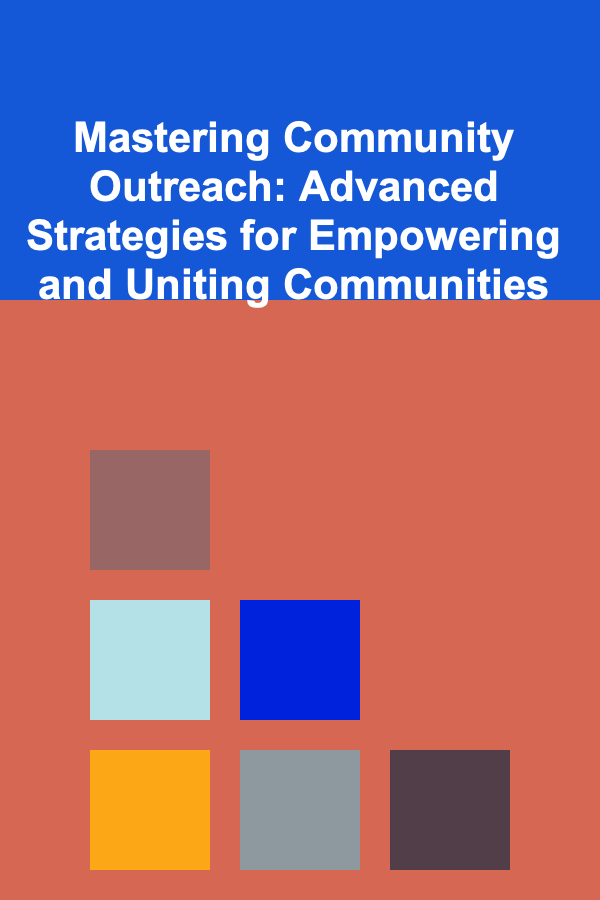
Mastering Community Outreach: Advanced Strategies for Empowering and Uniting Communities
ebook include PDF & Audio bundle (Micro Guide)
$12.99$7.99
Limited Time Offer! Order within the next:

Community outreach is not just about organizing events or distributing resources; it's about fostering a sense of unity, building sustainable relationships, and addressing both the immediate and long-term needs of the community. As an outreach coordinator or community leader, you must go beyond basic outreach techniques to master advanced strategies that can truly empower and unite people. This guide provides actionable insights into the deeper aspects of community outreach, focusing on innovative strategies, long-term engagement, and community-led empowerment.
Understanding the Core of Community Outreach
Effective community outreach is rooted in a clear understanding of the community you're serving. It's not just about doing things for people but empowering them to become active participants in their own growth and well-being. This process starts with a deep commitment to understanding the unique dynamics of the community and crafting strategies that speak to their needs, values, and aspirations.
At its core, community outreach is about connection. It involves mobilizing individuals and groups to address collective challenges, advocate for shared interests, and create lasting change. The process requires long-term dedication, cultural sensitivity, and a commitment to listening and learning from those you're trying to serve.
Establishing a Deep Community Understanding
Before embarking on any outreach project, it's crucial to truly understand the community you are serving. A deep understanding forms the foundation upon which all other outreach efforts will be built.
Conduct Community Assessments
The first step in any outreach initiative should be a comprehensive assessment of the community's needs, strengths, and challenges. This goes beyond simply surveying people; it involves engaging deeply with the community to uncover both visible and hidden issues. Community assessments can be carried out through:
- Focus Groups: Gathering small groups of community members to discuss key issues in a safe, open environment.
- Surveys: Distributing surveys that ask direct questions about the community's needs, resources, and experiences.
- Interviews with Community Leaders: Speaking with local leaders, influencers, and stakeholders who have an in-depth understanding of the community's dynamics.
- Observation: Spending time in the community, observing interactions and behavior to gain insights into the local culture and values.
The insights you gather from these assessments will help you shape your outreach strategies and ensure that your programs address real community needs, not perceived ones.
Building Local Trust
Trust is essential for any outreach initiative to be successful. Communities are often wary of external intervention, especially if they have experienced broken promises or failed projects in the past. Building trust starts with humility and transparency.
- Be Present: Spend time in the community even before you launch any programs. Attend local events, engage with people informally, and be a familiar face in the neighborhood.
- Listen More than You Speak: Rather than coming in with pre-determined solutions, listen attentively to what the community members have to say. This shows respect for their expertise and needs.
- Be Transparent: Be clear about your intentions, your goals, and how the community can benefit. Transparency fosters trust and helps build lasting relationships.
Engaging and Empowering Local Leaders
An essential part of community outreach is ensuring that local leaders are involved in every stage of the outreach process. These leaders could be formal or informal influencers within the community---people who have the respect and trust of others.
Identify Key Community Leaders
Leaders can be found in every corner of a community. They may be heads of local organizations, religious leaders, business owners, educators, or even grassroots activists. Identifying these leaders and engaging them in your outreach efforts will lend credibility and provide you with valuable insights into the community's dynamics.
- Formal Leaders: These might include elected officials, religious leaders, or heads of established community organizations.
- Informal Leaders: These individuals are often less visible but hold significant sway within the community. They may be teachers, local activists, or long-time residents with deep ties to the neighborhood.
Build Collaborative Partnerships
When you work with local leaders, you are not only gaining access to their networks but also empowering them to be champions of the cause. Encourage leaders to take ownership of the projects, helping them develop their own leadership skills while fostering a sense of collective responsibility within the community.
Focus on Capacity Building
Empowering community leaders means providing them with the tools and knowledge to succeed. Offer training, mentorship, and resources that allow these leaders to take charge of initiatives and serve as role models within the community.
Implementing Participatory Outreach
Traditional models of community outreach often treat the community as passive recipients of services or information. A more effective approach is participatory outreach, where community members are actively involved in the design, implementation, and evaluation of programs.
Co-Create Solutions with the Community
Instead of imposing solutions, engage community members in a collaborative process where they contribute ideas, help design interventions, and provide feedback. This approach not only ensures that solutions are more relevant but also builds a sense of ownership and commitment.
- Community Forums: Organize forums or town hall meetings where residents can openly discuss issues and contribute to the development of solutions.
- Workshops and Collaborative Events: Host workshops where community members can actively participate in designing programs or creating materials.
Foster a Culture of Participation
For participatory outreach to be effective, it needs to be embedded in the culture of the community. This requires building trust over time and encouraging ongoing participation. Instead of one-off events, create a culture of continuous involvement where community members are consistently encouraged to share their input, participate in decision-making, and take action.
Leveraging Technology for Outreach
In today's digital world, technology plays an important role in community outreach. It can expand the reach of your initiatives, improve engagement, and streamline operations. However, to use technology effectively, outreach coordinators must ensure that digital tools are accessible and used in ways that foster community engagement, not isolate it.
Use Social Media Strategically
Social media can be an incredibly powerful tool for outreach. Platforms like Facebook, Twitter, Instagram, and WhatsApp can be used to share information, build community, and engage with a broad audience. However, these tools should be used thoughtfully:
- Create Interactive Content: Encourage community members to participate in online polls, Q&A sessions, or virtual events.
- Provide Information and Resources: Use social media to share valuable resources, updates, and information that can help the community address its needs.
- Respond and Engage: Social media is a two-way street. Engage with community members' posts, answer questions, and show that their voices are heard.
Develop Community Apps or Platforms
For communities with access to smartphones and internet connections, developing a dedicated community app or online platform can be a game-changer. These platforms can serve as central hubs where people can find resources, connect with others, and stay up-to-date on local events and opportunities.
Sustaining Long-Term Engagement
Sustaining long-term engagement is perhaps the most challenging aspect of community outreach. Once an outreach program or initiative is launched, the real work begins in maintaining momentum and keeping community members involved.
Create Ongoing Opportunities for Involvement
Community engagement shouldn't stop after the initial outreach event. Create long-term opportunities for involvement, such as:
- Volunteer Programs: Offer regular opportunities for community members to volunteer and actively contribute to ongoing projects.
- Committees and Action Teams: Form committees or action teams made up of community members to help steer programs and initiatives.
- Regular Check-ins: Maintain an ongoing dialogue with the community, ensuring that their needs are still being met and adjusting your strategies as needed.
Evaluate and Adapt Programs
An essential part of maintaining engagement is regularly evaluating your programs and making necessary adjustments. Continuously gather feedback from the community, assess whether your programs are achieving their goals, and adapt based on lessons learned.
- Conduct Impact Assessments: Measure the effectiveness of your outreach efforts and gather feedback from participants to understand what is working and what could be improved.
- Adapt to Changing Needs: Communities evolve, and so should your outreach strategies. Be open to change and ready to adapt your programs to new challenges or emerging opportunities.
Conclusion: Empowering Communities for the Long Haul
Mastering community outreach requires a blend of deep understanding, collaboration, strategic planning, and ongoing engagement. The goal is not simply to address immediate concerns but to create a framework for long-term community empowerment. By engaging local leaders, utilizing technology, fostering participatory practices, and sustaining ongoing dialogue, you can build communities that are resilient, self-sustaining, and united.
Effective outreach is about more than just distributing resources---it's about creating lasting relationships and empowering individuals to take ownership of their own futures. By mastering these advanced strategies, you can make a profound impact on the communities you serve and create a lasting legacy of positive change.

Best Practices for Writing Compelling Copy for One-Page Websites
Read More
How to Create a Smart Home Setup in a Small Apartment
Read More
How to Generate Passive Income by Licensing Deep Learning Models
Read More
How To Learn Basic Data Entry Efficiency
Read More
How to Plan for Financial Stability After a Divorce
Read More
How to Set Conference Goals and Objectives: An Actionable Checklist
Read MoreOther Products

Best Practices for Writing Compelling Copy for One-Page Websites
Read More
How to Create a Smart Home Setup in a Small Apartment
Read More
How to Generate Passive Income by Licensing Deep Learning Models
Read More
How To Learn Basic Data Entry Efficiency
Read More
How to Plan for Financial Stability After a Divorce
Read More